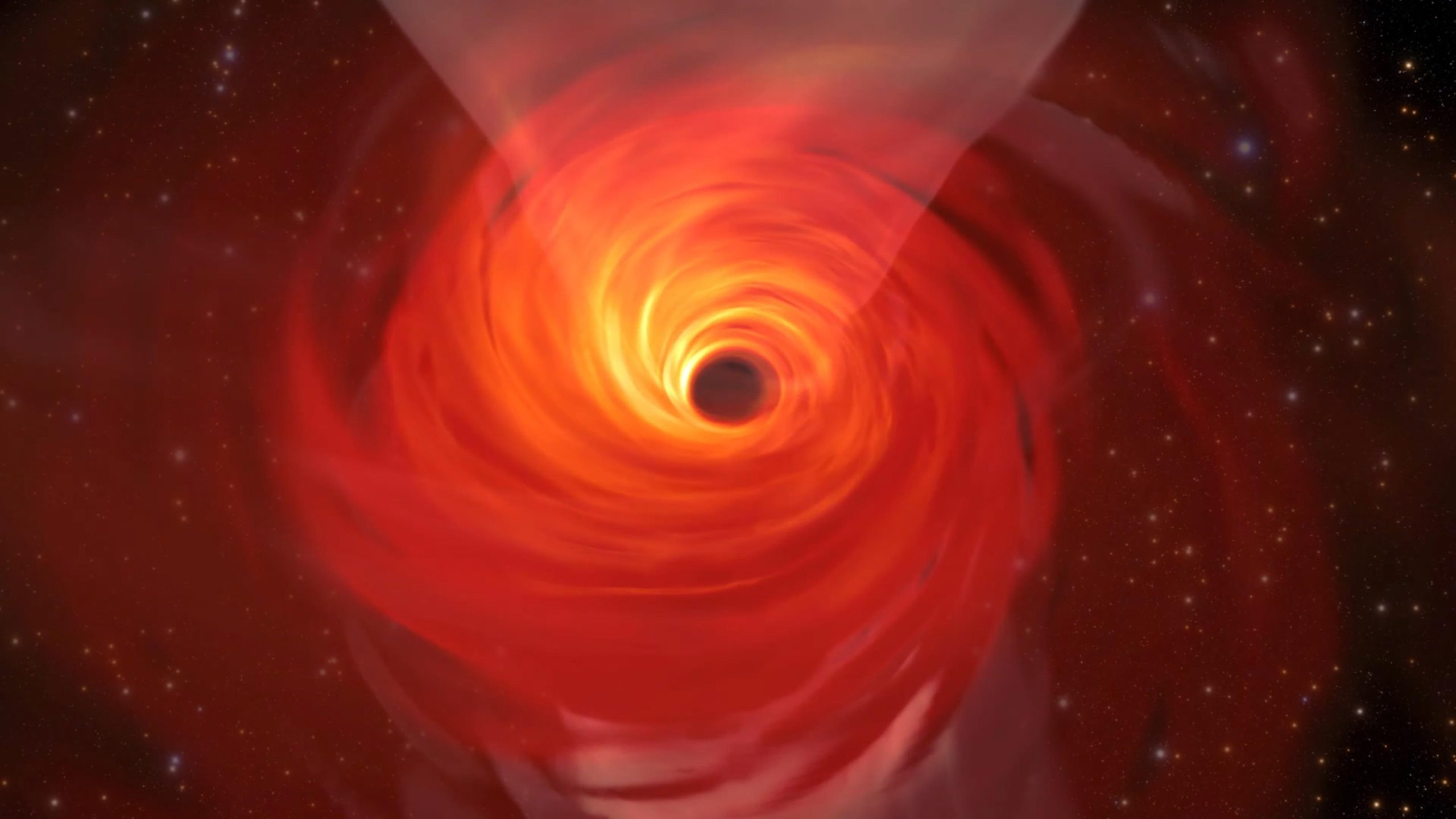
Los astrónomos han detectado signos de un «punto caliente» que orbita alrededor de Sagitario A*, el agujero negro en el centro de nuestra galaxia.
Los astrónomos han detectado signos de un «punto caliente» que orbita alrededor de Sagitario A*, y[{» attribute=»»>black hole at the center of our galaxy, using the Atacama Large Millimeter/submillimeter Array (ALMA). The finding helps us better understand the enigmatic and dynamic environment of our supermassive black hole.
“We think we’re looking at a hot bubble of gas zipping around Sagittarius A* on an orbit similar in size to that of the planet Mercury, but making a full loop in just around 70 minutes. This requires a mind-blowing velocity of about 30% of the speed of light!” says Maciek Wielgus of the Max Planck Institute for Radio Astronomy in Bonn, Germany. He led the study that was published today (September 22, 2023) in the journal Astronomy & Astrophysics.

This shows a still image of the supermassive black hole Sagittarius A*, as seen by the Event Horizon Collaboration (EHT), with an artist’s illustration indicating where the modeling of the ALMA data predicts the hot spot to be and its orbit around the black hole. Credit: EHT Collaboration, ESO/M. Kornmesser (Acknowledgment: M. Wielgus)
The observations were made with ALMA in the Chilean Andes, during a campaign by the Event Horizon Telescope (EHT) Collaboration to image black holes. ALMA is — a radio telescope co-owned by the European Southern Observatory (ESO). In April 2017 the EHT linked together eight existing radio telescopes worldwide, including ALMA, resulting in the recently released first-ever image of Sagittarius A*. To calibrate the EHT data, Wielgus and his colleagues, who are members of the EHT Collaboration, used ALMA data recorded simultaneously with the EHT observations of Sagittarius A*. To the research team’s surprise, there were more clues to the nature of the black hole hidden in the ALMA-only measurements.
Usando ALMA, los astrónomos han encontrado una burbuja de gas caliente que orbita Sagitario A*, el agujero negro en el centro de nuestra galaxia, al 30% de la velocidad de la luz.
Por casualidad, se realizaron algunas observaciones poco después de que se emitiera una explosión o resplandor de energía de rayos X desde el centro de nuestra galaxia, que fue observado por[{» attribute=»»>NASA’s Chandra X-ray Observatory. These kinds of flares, previously observed with X-ray and infrared telescopes, are thought to be associated with so-called ‘hot spots’, hot gas bubbles that orbit very fast and close to the black hole.
“What is really new and interesting is that such flares were so far only clearly present in X-ray and infrared observations of Sagittarius A*. Here we see for the first time a very strong indication that orbiting hot spots are also present in radio observations,” says Wielgus, who is also affiliated with the Nicolaus Copernicus Astronomical Center, in Warsaw, Poland and the Black Hole Initiative at Harvard University, USA.
Este video muestra una animación de un punto caliente, una burbuja de gas caliente, en órbita alrededor de Sagitario A*, un agujero negro cuatro millones de veces más grande que nuestro Sol en el centro de nuestro planeta.[{» attribute=»»>Milky Way. While the black hole (center) has been directly imaged with the Event Horizon Telescope, the gas bubble represented around it has not: its orbit and velocity are inferred from both observations and models. The team who discovered evidence for this hot spot — using the Atacama Large Millimeter/submillimeter Array (ALMA), in which ESO is a partner — predicts the gas bubble orbits very close to the black hole, at a distance about five times larger than the black hole’s boundary or “event horizon.”
The astronomers behind the discovery also predict that the hot spot becomes dimmer and brighter as it goes around the black hole, as indicated in this animation. Additionally, they can infer that it takes 70 minutes for the gas bubble to complete an orbit, putting its velocity at an astonishing 30% of the speed of light.
Credit: EHT Collaboration, ESO/L. Calçada (Acknowledgment: M. Wielgus)
“Perhaps these hot spots detected at infrared wavelengths are a manifestation of the same physical phenomenon: as infrared-emitting hot spots cool down, they become visible at longer wavelengths, like the ones observed by ALMA and the EHT,” adds Jesse Vos. He is a PhD student at Radboud University, the Netherlands, and was also involved in this study.
The flares were long thought to originate from magnetic interactions in the very hot gas orbiting very close to Sagittarius A*, and the new findings support this idea. “Now we find strong evidence for a magnetic origin of these flares and our observations give us a clue about the geometry of the process. The new data are extremely helpful for building a theoretical interpretation of these events,” says co-author Monika Moscibrodzka from Radboud University.

This is the first image of Sgr A*, the supermassive black hole at the center of our galaxy. It’s the first direct visual evidence of the presence of this black hole. It was captured by the Event Horizon Telescope (EHT), an array that linked together eight existing radio observatories across the planet to form a single “Earth-sized” virtual telescope. The telescope is named after the event horizon, the boundary of the black hole beyond which no light can escape. Credit: EHT Collaboration
ALMA allows astronomers to study polarized radio emission from Sagittarius A*, which can be used to unveil the black hole’s magnetic field. The team used these observations together with theoretical models to learn more about the formation of the hot spot and the environment it is embedded in, including the magnetic field around Sagittarius A*. Their research provides stronger constraints on the shape of this magnetic field than previous observations, helping astronomers uncover the nature of our black hole and its surroundings.

This image shows the Atacama Large Millimeter/submillimeter Array (ALMA) looking up at the Milky Way as well as the location of Sagittarius A*, the supermassive black hole at our galactic center. Highlighted in the box is the image of Sagittarius A* taken by the Event Horizon Telescope (EHT) Collaboration. Located in the Atacama Desert in Chile, ALMA is the most sensitive of all the observatories in the EHT array, and ESO is a co-owner of ALMA on behalf of its European Member States. Credit: ESO/José Francisco Salgado (josefrancisco.org), EHT Collaboration
The observations confirm some of the previous discoveries made by the GRAVITY instrument at ESO’s Very Large Telescope (VLT), which observes in the infrared. The data from GRAVITY and ALMA both suggest the flare originates in a clump of gas swirling around the black hole at about 30% of the speed of light in a clockwise direction in the sky, with the orbit of the hot spot being nearly face-on.
“In the future, we should be able to track hot spots across frequencies using coordinated multiwavelength observations with both GRAVITY and ALMA — the success of such an endeavor would be a true milestone for our understanding of the physics of flares in the Galactic center,” says Ivan Marti-Vidal of the University of València in Spain, co-author of the study.

Wide-field view of the center of the Milky Way. This visible light wide-field view shows the rich star clouds in the constellation of Sagittarius (the Archer) in the direction of the center of our Milky Way galaxy. The entire image is filled with vast numbers of stars — but far more remain hidden behind clouds of dust and are only revealed in infrared images. This view was created from photographs in red and blue light and forming part of the Digitized Sky Survey 2. The field of view is approximately 3.5 degrees x 3.6 degrees. Credit: ESO and Digitized Sky Survey 2. Acknowledgment: Davide De Martin and S. Guisard (www.eso.org/~sguisard)
The team is also hoping to be able to directly observe the orbiting gas clumps with the EHT, to probe ever closer to the black hole and learn more about it. “Hopefully, one day, we will be comfortable saying that we ‘know’ what is going on in Sagittarius A*,” Wielgus concludes.
More information
Reference: “Orbital motion near Sagittarius A* – Constraints from polarimetric ALMA observations” by M. Wielgus, M. Moscibrodzka, J. Vos, Z. Gelles, I. Martí-Vidal, J. Farah, N. Marchili, C. Goddi and H. Messias, 22 September 2023, Astronomy & Astrophysics.
DOI: 10.1051/0004-6361/202244493
The team is composed of M. Wielgus (Max-Planck-Institut für Radioastronomie, Germany [MPIfR]; Centro Astronómico Nicolás Copérnico, Academia Polaca de Ciencias, Polonia; La Iniciativa Black Hole de la Universidad de Harvard, EE. UU. [BHI]), M. Moscibrodzka (Departamento de Astrofísica, Universidad de Radboud, Países Bajos [Radboud]), J. Vos (Radboud), Z. Gelles (Centro de Astrofísica | Harvard & Smithsonian, EE. UU. y BHI), I. Martí-Vidal (Universitat de València, España), J. Farah (Observatorio de Las Cumbres, EE. UU.; Universidad de California, Santa Bárbara, EE. UU.), N. Marchili (Centro Regional Italiano ALMA, INAF-Istituto di Radioastronomia, Italia y MPIfR), C. Goddi (Dipartimento di Fisica, Università degli Studi di Cagliari, Italia y Universidade de São Paulo, Brasil), y H. Messias (Observatorio Conjunto ALMA, Chile).
El Atacama Large Millimeter/submillimeter Array (ALMA), una instalación astronómica internacional, es una asociación entre ESO, la Fundación Nacional de Ciencias de EE. UU. (NSF) y los Institutos Nacionales de Ciencias Naturales (NINS) de Japón en colaboración con la República de Chile. ALMA está financiado por ESO en nombre de sus estados miembros, por NSF en colaboración con el Consejo Nacional de Investigación de Canadá (NRC) y el Ministerio de Ciencia y Tecnología (MOST) y por NINS en colaboración con Academia Sinica (AS) en Taiwán y el Instituto Coreano de Astronomía y Ciencias Espaciales (KASI). ). La creación y las operaciones de ALMA están dirigidas por ESO en nombre de sus estados miembros; Por el Observatorio Nacional de Radioastronomía (NRAO), operado por Associated Universities, Inc. (AUI), en nombre de América del Norte; Y por el Observatorio Astronómico Nacional de Japón (NAOJ) en nombre de Asia Oriental. El Observatorio Conjunto de ALMA (JAO) proporciona liderazgo y gestión unificados para la construcción, operación y operación de ALMA.
El Observatorio Europeo Austral (ESO) permite a los científicos de todo el mundo descubrir los secretos del universo en beneficio de todos. Diseñamos, construimos y operamos observatorios de clase mundial en la Tierra, que los astrónomos utilizan para abordar preguntas interesantes y difundir la magia de la astronomía, y promovemos la cooperación internacional en astronomía. Fundado como una organización intergubernamental en 1962, hoy ESO apoya a 16 estados miembros (Austria, Bélgica, República Checa, Dinamarca, Francia, Finlandia, Alemania, Irlanda, Italia, Países Bajos, Polonia, Portugal, España, Suecia, Suiza y el Reino Unido ), junto con el país anfitrión Chile y con Australia como socio estratégico. La sede, el centro de visitantes y el planetario de ESO, ESO Supernova, se encuentran cerca de Munich en Alemania, mientras que el desierto chileno de Atacama, un lugar maravilloso con condiciones únicas para observar el cielo, alberga nuestros telescopios. ESO opera tres sitios de monitoreo: La Silla, Paranal y Chajnantor. En Paranal, ESO opera el Very Large Telescope y su Very Large Telescope Interferometer, así como dos telescopios infrarrojos y el telescopio de luz visible VLT. También en Paranal, ESO albergará y operará el Telescopio South Array Cherenkov, el observatorio de rayos gamma más grande y sensible del mundo. Junto con socios internacionales, ESO opera APEX y ALMA en Chajnantor, dos instalaciones de monitoreo del cielo milimétricas y submilimétricas. En Cerro Armazones, cerca de Paranal, estamos construyendo el «ojo más grande del mundo en el cielo»: el Very Large Telescope de ESO. Desde nuestras oficinas en Santiago, Chile, apoyamos nuestras operaciones en el país y trabajamos con socios y la comunidad chilena.

«Web friki. Wannabe pensador. Lector. Evangelista de viajes independiente. Aficionado a la cultura pop. Erudito musical certificado».






